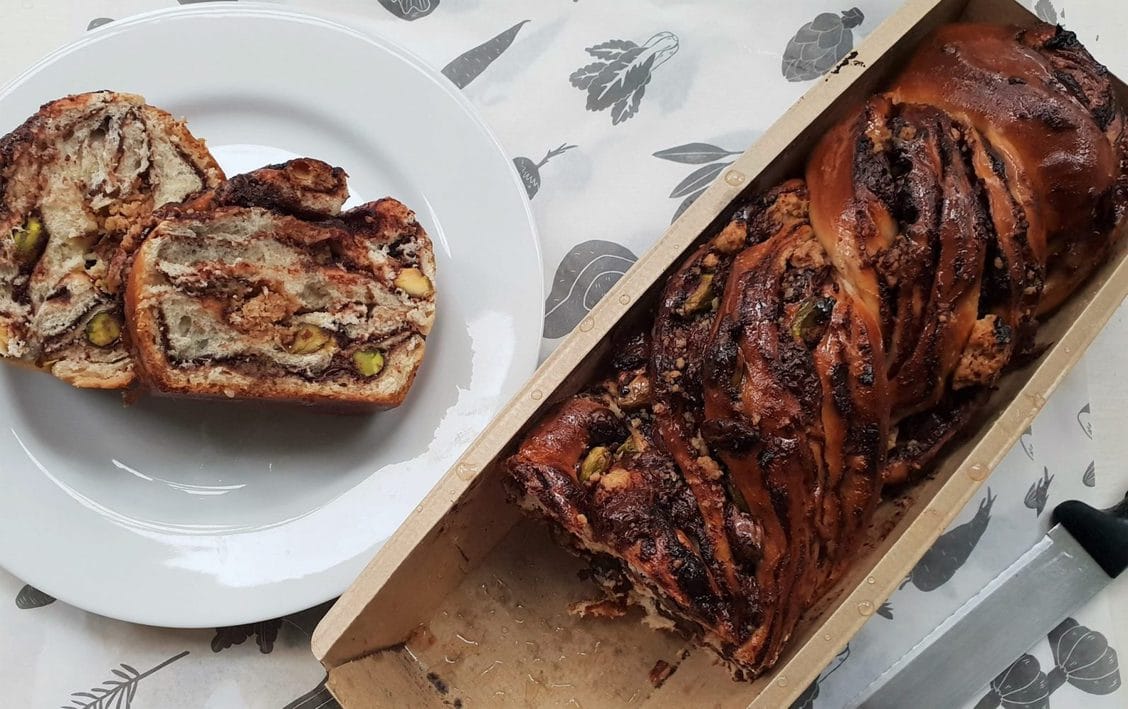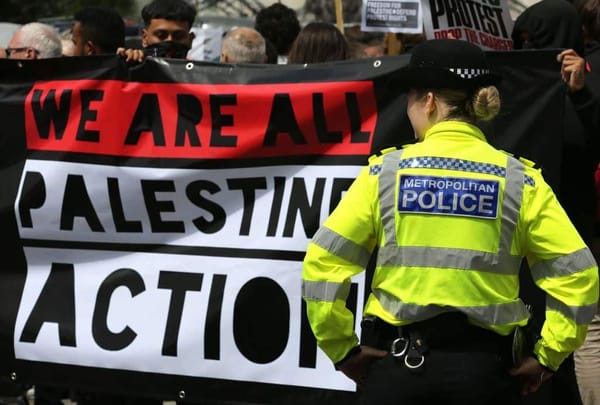Bougie babka
The gentrification of a yiddishe yeast cake.

The last place I thought I’d see babka was at my local coffee shop. I had gone for my usual coffee run some time deep into the pandemic, when a coffee run was a daily milestone. I arrived at a pared-back, trendy space in Highbury that sold a small selection of baked goods. Next to the till, I spotted them: a pile of chocolate babka, wrapped individually and swaddled in pan liners.
Naturally, I had to bring one home to my non-Jewish housemates. “What is this?” they thrilled, shovelling mouthfuls and staining their fingers with chocolate. It was different from the chalkier babka of my childhood, more cake-like. I thought it was a fun novelty, a blip that my local cafe was selling an obscure Jewish treat. Over the next few months, I saw babka everywhere.
Nearly every single bakery or coffee shop across town was suddenly selling their own version. I saw food influencers showing off their homemade babkas on Instagram; baking tutorials from Vice and Eater. Often, babka was presented without cultural context; its Jewishness was incidental, if mentioned at all.
Of course, not everything we eat needs to be contextualised, but babka’s sudden and inescapable popularity in London raises questions about how it’s being consumed.
The conversation around food gentrification started relatively recently. Early discussions focussed on the impact of urban displacement on food prices and access to ingredients by locals. In his 2018 paper ‘Food, Gentrification, and the Changing City’, Joshua Sbicca traces the dialogue back to a set of 2014 tweets from Black feminist food blogger Mikki Kendall, who raised concerns that the commodification of poor communities’ foodways might mean that Black Americans couldn’t afford traditional soul food. Since then, the conversation has expanded into symbolism and cultural appropriation, with the main question being: who has the right to make and sell food from a specific tradition?
Sbicca cites two main schools of thought on gentrification. The first relies on Marxist political economy and posits that capitalism, as a growth-based system, compels urban elites to commodify land in order to increase economic growth, leading to persistent expansion into new, less-developed geographical areas.
The second approach, more angled towards consumption, posits that post-industrial cities – those with service- and knowledge-based economies –have become more attractive for the “creative classes” that have moved back from the suburbs and into urban centres in search of “perceived opportunit[ies] for authentic living”.
In both cases, gentrified food holds essential symbolic value: for wealthy newcomers, expensive versions of once local foodstuffs indicate that property values are increasing and provide the desired authenticity.
In London, this tension plays out in the city’s geography, and the results are often stark. In his introduction to the ‘Feeding Finsbury Park’ edition of his newsletter Vittles, Jonathan Nunn notes that “micro-segregations” can be seen in neighbourhoods like Brixton, where the railway becomes a literal dividing line between the gentrified and non-gentrified: on one side of the arches, you’ll find a new craft beer bar and a small plates Japanese restaurant; on the other, two longstanding institutions an Ethiopian cafe and a snack bar.
The gentrification of babka doesn’t have the same spatial analogue. Jewish bakeries like Rinkoff’s and Roni’s are in neighbourhoods (London’s Spitalfields and Hampstead respectively) that have long been changed by the arrival of the creative classes and are no longer home to the historic Jewish communities they once served. Instead of Jewish businesses being pushed out by gentrification, Jewish goods like babka are being absorbed by non-Jewish institutions. At non-Jewish bakeries and cafes, they are severed from context, and thus become floating signifiers: to many, babka doesn’t suggest Jewish heritage, but something aspirational. It suggests that the businesses carrying them are trendy.
Humble beginnings
Most food historians believe babka originated in the shtetls of eastern Europe, evolving from a pastry indigenous to the Ukraine that was used to symbolise fertility. Rinkoff’s – a family-run bakery in east London that’s been in business since 1911 – bakes this eastern European style of babka, which is said to be the most “traditional” variety. Jennifer Rinkoff – current manager and great-great-granddaughter of Rinkoff’s founder, Hyman Rinkoff – believes that a babka should retain certain characteristics, namely that the dough should be “more like bread than cake”, and that it should contain sweet fillings like chocolate, cinnamon or jam. For Jennifer, babka containing meat or savoury fillings isn’t babka.
But babka sold around London often does contain a variety of fillings, and it almost never adheres to the traditional convention of using oil as a fat so that it becomes parve, ie meat and dairy free (note: Rinkoff’s isn’t a kosher bakery, so its version isn’t truly parve). At Shuk, a “Tel Aviv-style” stall in Borough Market, owner Mark Jankel began experimenting with babka when his business was forced to shut during the pandemic. Rather than the typical chocolate spread you see in most Israel-style babkas, theirs contains a chocolate and hazelnut filling that’s sprinkled with cookie dough, and they use “lots of butter” in their dough. They conceived of a DIY “babka kit” they could send out to people isolating at home, which contained the ready-made dough and fillings, plus instructions on how to properly twist and bake it.
Shuk has experimented with lots of different babka varieties – including a “hot cross babka” for Easter, a cheese and Marmite babka and a “hamburger babka” stuffed with beef. They clearly don’t adhere closely to tradition, but Mark doesn’t see this as a problem. “I don’t think it bothers me,” he tells me. “I think it’s nice for something that’s traditional to evolve to use better ingredients and become something even better.”
But if traditional babka being sold in London is outnumbered by non-traditional babka, has its cultural significance been distorted? Of course, tradition is fluid, and babka-bakers don’t have a moral imperative to preserve Jewish food customs. And, though the eastern European babka might be said to be archetypal, it too has evolved: when it was brought over the the US in the mid-20th century, it was American-Jewish bakers who added the now-iconic chocolate.
But it’s worth asking what is lost when we lean too far into originality, and at what point a food’s cultural history gets lost in the noise. When food influencer after food influencer broadcasts babka to their followers without acknowledging to Jewish tradition, what are they doing to a cake that was once a treat for poor Jewish immigrants?
As babka moves from the ghetto to the suburbs, we need to recall the historical context that birthed it. Jennifer wants Rinkoff’s customers to remember that babka originated in eastern European communities like the one her great-grandfather came from, especially since “there aren’t many [Jewish bakeries] left in London.” As Devorah Romanek notes in her paper ‘Diaspora Identities: Jewish Bakeries and Bakes Goods in London and Berlin’, Jewish baking was never just about subsistence – it is also a vehicle for “constructing a concept of the self, community, and culture”, one spiralled loaf at a time.▼
Jessica Prupas is a Canadian-born, London-based writer and editor. She writes mostly about food, travel and how identity is formed through both.




